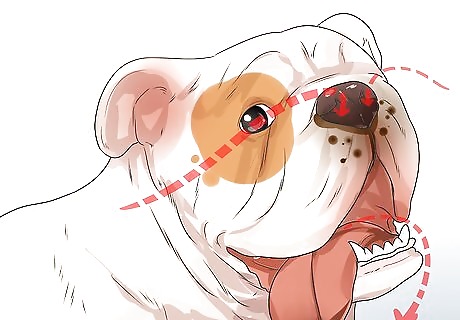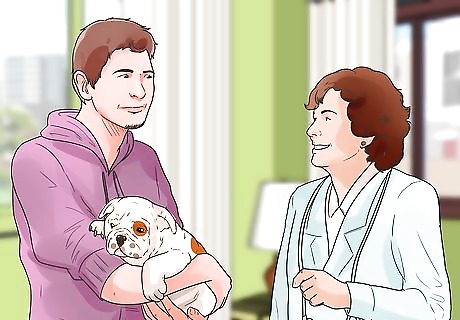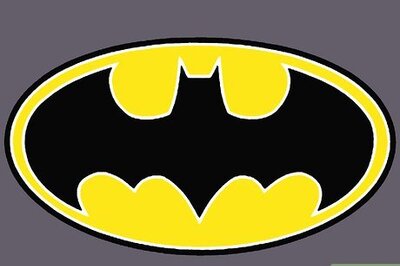
views
X
Research source
However, the bulldog's flattened face also causes it significant breathing problems due to the altered anatomy of the nose, throat, and windpipe. Bulldogs are affected not by one problem, but by a group of issues related to their shortened heads, which come under the common heading of brachycephalic airway obstructive syndrome (BAOS).[2]
X
Research source
This means the bulldog struggles with vigorous exercise, is prone to heatstroke in hot weather, and, if severely affected, may even need corrective surgery or treatment to avoid slow suffocation.
Giving at Home Care

Keep an eye on your dog's breathing. If you have a bulldog you should always be on the look out for signs of breathing distress. If you notice labored breathing early, it can help your dog avoid the discomfort of severe breathing difficulty. If you are walking your dog, continually assess how the dog is breathing and if it is having difficulty. Signs of breathing difficulty include excessive wheezing, panting, and, in extreme cases, passing out.

Give your dog lots of rest. Do not over exercise a dog that has difficulty breathing. While we all want our dogs to get plenty of exercise to stay healthy, the health of a dog with respiratory problems can actually be put at risk when forced into extreme exercise. Once breathing becomes labored, you need to allow the dog to recover its breathe. If the dog is breathing very hard, do not ask the dog to walk to a shady spot or cool room. Instead, pick it up and carry it. Under normal conditions, your dog should recover its breath in a few minutes. However, if it is hot or your dog has a severe respiratory issue, it may take the dog longer to recover.

Cool the dog down. If your dog is overheated and having respiratory problems, you need to cool the dog down. If breathing becomes exaggerated, immediately let it rest in a cool place. You should also offer it cool water to drink. This can help to cool the dog down on the inside.

Be prepared to take your dog to a veterinarian. If your dog's breathing does not improve rapidly, phone your vet. Tell them you have a possible emergency. Be prepared to tell the veterinarian about your dog's symptoms and how long they have been going on. Keep the dog calm, quiet, and cool on the way to the clinic.
Getting Veterinary Treatment

Get emergency veterinary treatment for a dog having labored breathing. The vet can give cool intravenous fluids if the dog is overheated. The vet can also put it in an oxygen tent to aid its breathing. In addition, drugs such as corticosteroids can relieve swelling at the back of the throat, that has arisen as a result of increased breathing efforts. However, if the dog's problems are severe enough to warrant emergency treatment then corrective surgery once the dog is stable, should be considered.

Consider surgical correction of BAOS. Depending on the extent and type of problem you bulldog has, it may be able to be corrected. This is especially true if the dog is young, as it will recover from surgery more easily. Your vet may consider the following options in order to improve your bulldog's breathing: Nostril surgery: Corrective surgery means removing a cake-slice of flesh from the nostrils with the intent of making the nostrils wider to facilitate breathing through the nose. Soft palate surgery: Trimming away the excess length of soft palate means the back of the throat is clearer and the windpipe less likely to become plugged with the palate from time to time. Laryngeal saccules removal: Specialist surgeons can remove the laryngeal saccules, hence removing another obstruction from the back of the throat. Unfortunately, there is no surgery that can fix a relatively oversized tongue or the small diameter of the windpipe.

Give post-operative care. Dogs that go through surgery and anesthesia may have a hard recovery. Your dog may be groggy and lethargic for quite awhile. Overall, make sure your dog is gradually recovering and follow all directions that come from your veterinary surgeon. Keep an eye on your dog for signs that it is having difficulty breathing. If it is, call the veterinarian and take the bulldog in for treatment. Even after surgery your dog may have difficulty breathing in extreme conditions. Take sensible precautions, such as not over-exerting your dog in the heat. Also, use a harness rather than a collar, as this puts less pressure on the windpipe, making it easier to breathe.
Identifying Respiratory Problems

Look for labored breathing at rest. Think of a normal dog and usually at rest they breathe steadily and silently through their nose, with no panting involved. Now consider the bulldog at rest, who is likely to pant with an open mouth, snort, and breathe so loudly you can hear it from the next room. This is not just a cute attribute of the bulldog but indicates a compromised respiratory tract.

Pay attention to the dog's behavior while active. When more demands are placed on its respiratory system, such as during exercise or hot weather, the signs of BAOS are exaggerated. These include: Excessive heavy panting: The dog will pant a lot, with a tongue that becomes very dry and strings of sticky saliva hanging from its lips. Reluctance to move: The dog stubbornly refuses to move because to do so requires extra oxygen that it does not have. Choking or snoring sounds: Typically these sounds are made as a result of the soft palate being sucked into the windpipe. Pale or blue-tinged gums: A warning sign that the dog is distressed is that the normally pink membranes of its mouth look pale or blue-tinged. Collapse: If the dog cannot get in enough oxygen it will collapse and faint.

Assess whether your bulldog has the physical attributes that could bring on BAOS. This will signal that you should be on the look out for symptoms. The significant components of BAOS include: Narrow nostrils: This makes it difficult for the bulldog to breathe in through its nose Foreshortened nose: This means the bony scrolls (or turbinates) inside the nose are compressed into a smaller space. Large tongue: Although bony structures, such as the nose, are shortened, the tongue is a regular size. Thus the tongue takes up too much room inside the mouth and blocks the back of the throat. Overlong soft palate: The flap of flesh at the back of the throat that separates the nose from the mouth, and prevents food going down the windpipe, is too long relative to the size of the nose. This means yet more tissue occupying the back of throat, and its location makes it prone to being sucked into the windpipe and making choking noises. Everted laryngeal saccules: Glandular tissue at the back of the throat (equivalent to tonsils) gets sucked out of the area they should sit in. This leads to them intruding into the airway and further cutting down on the ability to breathe. Hypoplastic windpipe: Unfortunately, selectively breeding for a flat face led to selection of dogs that also have an unnaturally narrow windpipe. This means the tube connected to the lungs is too narrow, adding another layer of difficulty to breathing.



















Comments
0 comment